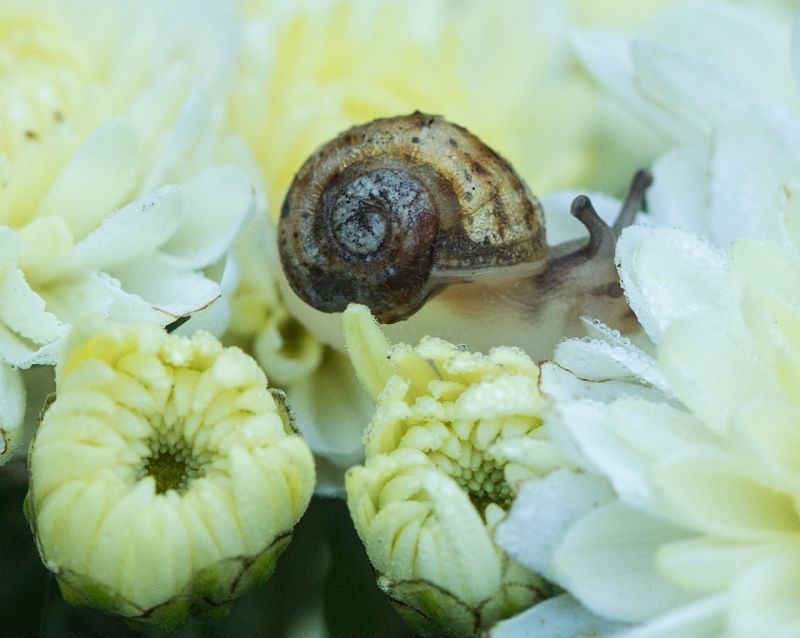It's September, and just about time for the chrysanthemums we've been nursing through the summer with buckets of dishwater to enjoy their autumn moment. Looking at the hundreds or thousands of unfolding buds on a recent morning in Berkeley, I noticed a familiar garden visitor: Cornu aspersum, also known as the brown snail, garden snail, brown garden snail, European garden snail, or European brown garden snail (in French, its common name is apparently petit-gris, or little gray). Some of the snails were young, smaller than the just-opening buds they're presumably feeding on.
The University of California's Division of Agriculture and Natural Resources reports there are about 280 species of snails and slugs here in the Golden State, of which 242 are believed to be natives. Cornu aspersum (formerly Helix aspersa) is one of the many non-native species, including eucalyptus, striped bass and Homo sapiens, that make California what it is today.
C. aspersum is native to the western Mediterranean, probably originating in North Africa and migrating millions of years ago into Europe. Thanks to much more recent human genius and/or carelessness, the snail is reportedly now at home on every continent except that very cold one well to the south of us.
How did this land mollusk come to California? I remember hearing when I had newly introduced myself into this bioregion that they were the same species as one served to gastrophiles as escargot. In fact, I was told that Bay Area locals had been known to capture snails, feed them cornmeal to cleanse their digestive systems of whatever vile material they might have been eating, then consume them. I can't say I've ever met someone who claims to have done this themselves.
The April 27, 1900, number of the journal Science includes an article titled "Exotic Mollusca in California," by Robert Edwards Carter Stearns of Los Angeles. Stearns related a very specific genesis story for the European snails in California:
"This species was intentionally introduced or 'planted' in Calfornia over 40 years ago by Mr. A. Delmas, of San José, Santa Clara county, who brought the stock from France and turned it out among the vineyards on the west bank of the Guadalupe, a small river that flows northerly through Santa Clara Valley and empties into the southerly end of San Francisco bay near Alviso. The soil where the snails were placed is a rich sandy loam and the place well shaded. When the summer heats reach the maximum, the Helices descend into the ground several feet, hiding in the cracks that form, as the ground dries, and the gopher-holes also furnish cool retreats and protection. The region above named is one of exceeding fertility. It was settled by a few French families. The introduction of H. aspersa by Mr. Delmas was made for edible purposes, or in common parlance 'with an eye to the pot.' Mrs. Bush, of the Normal School in San José, informs me that the snails have thriven, and have extended their territory from the starting point on the west bank of the stream to the easterly side, and have multiplied to such an extent, that in some instances they are troublesome in the gardens."
Stearns also reported Delmas had planted the snails in San Francisco, where they did not do well at first, and Los Angeles, where they apparently thrived. By 1900, it had taken hold in other locations.

